Egypt’s residential real estate market has recorded impressive results thanks to persistently high demand.
Investment is being fueled by Egypt’s fast-growing population of around 90m – which increases by approximately 2.2% each year, according to the World Bank – as well as interest from abroad, as Egyptian expatriates look to capitalize on the weaker Egyptian pound.
For many Egyptians, property is seen as one of the safest investments, particularly with the country’s currency under pressure, as well as a hedge against inflation, which has historically been a problem. Investment properties are particularly popular for resale or rental at a later date.
Public and private investments in the property market totaled LE47.5bn ($5.3bn) in FY 2014/15, which ended in June 2015, contributing around 5% to GDP. A decade earlier investments stood at LE6.58bn ($741m) for the fiscal year ending in June 2005, according to Ministry of Housing (MoH) figures.
Investor interest
The current market environment is also drawing a range of domestic and international investors, including local developer Palm Hills – which has seen success with its Palm Valley West Cairo project and expects to deliver a total of 1800 housing units this year – and Dubai-based Emaar Properties, which has sold over 2150 units in Egypt to date.
Currency depreciation, combined with greater political stability, also draws interest from Egyptians abroad, who are looking to invest in second properties, Nick Maclean, managing director for the Middle East at CBRE, told local media.
Maclean highlighted the success of developments around Cairo, such as Pyramids Heights, Smart City and Cairo Festival City, which have drawn interest from the international market.
Well-off expatriates tend to prefer houses in these kinds of gated communities or compounds, and prefer paying in instalments, which are offered by many developers, rather than taking out mortgages, according to Ismail Yehia, CEO of Trends Real Estate, an Egyptian real estate company.
“The market will pick up in June when many Egyptian expatriates living in the Gulf return for Ramadan and look for investments in the country,” Yehia told OBG.
Rental prices of apartments and villas in New Cairo, for example, a growing suburb popular with the upwardly mobile, rose by 10% last year, according to JLL’s “Q3 2015 Cairo Real Estate Market Overview”.
“To a great extent, the price increases reflect the falling Egyptian pound and broader inflation, but demand is certainly strong,” Magued Sherif, managing director of Sixth of October Development and Investment Company (SODIC), told OBG. “Housing units are selling as fast as they can be built with pre-sales for developers as high as 70-80%.”
As a result, property prices could rise by between 20-30% this year, according to media reports.
There are some concerns that too many investors piling into the property market at a time when Egypt’s economy is still somewhat fragile may lead to oversupply or an asset bubble.
Affordability gap
The country’s yearly weddings – nearly 900,000 – are also a major driver of demand, as newly married couples look to move into their own homes and invest in property for the future, according to SODIC’s Sherif.
He estimates that Egypt’s housing gap – long a major issue in the country – is nearing 3m units. "Private developers collectively provide about 20,000 units per year, but this barely scratches the surface of the housing gap,” Sherif added.
According to forecasts from Colliers, a real estate services company, an extra 90,000 to 100,000 units will be needed per year through to 2020 to meet demand, which is well above the annual average of 45,000 units that have come on-line in recent years.
Major developers continue to focus on more affluent segments of the population, which are seen as yielding higher profits, rather than the poor and low-middle income groups, for whom the current housing shortage is most pressing.
The majority of Cairenes, or about 52%, are able to afford units in the $26,000-to-$35,000 range, but there is little to no supply offered by the private sector at this price point, according to a 2016 report on Cairo’s real estate market by Colliers.
The most affordable private developments, such as a 130-sq-metre unit in 6th of October City, tend to sell in the $60,000-to-$65,000 range.
The government is looking to address the shortfall in affordable housing partly through partnerships with the private sector.
In mid-May local press reported that the MoH was in talks with Kuwaiti investment company Al Juwisry to develop a social housing project on a 14,000-sq-metre plot in 6th of October City, as part of a larger $800m investment program.
Many private sector developers, however, will likely continue to target the higher end of the market, underscoring the importance of government-led efforts to incentivize social housing.
Oxford Business Group
6 June
























































